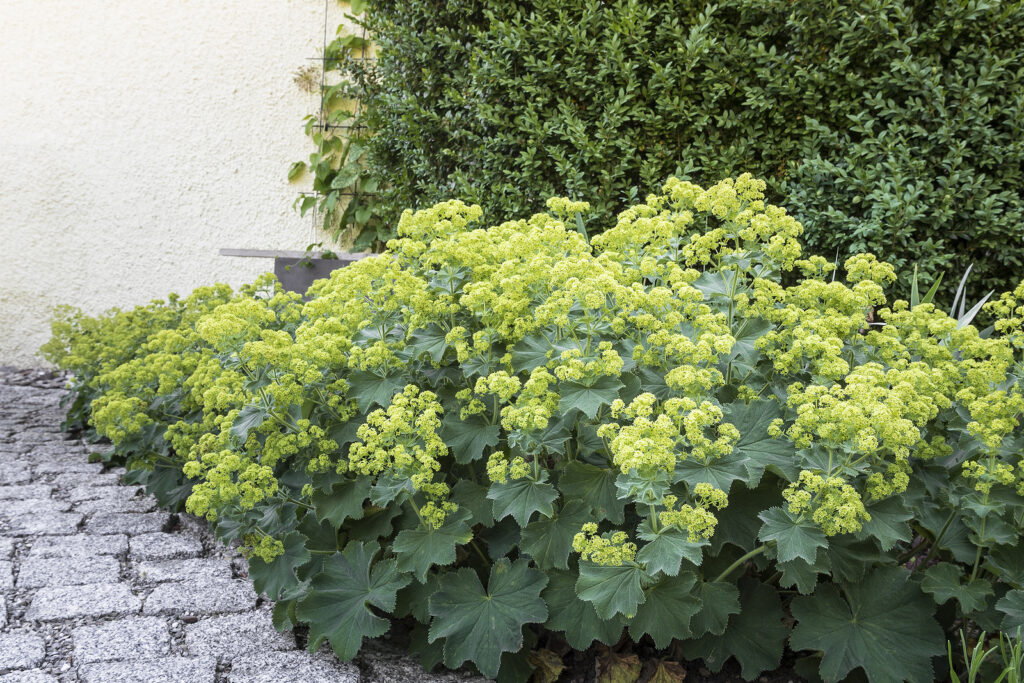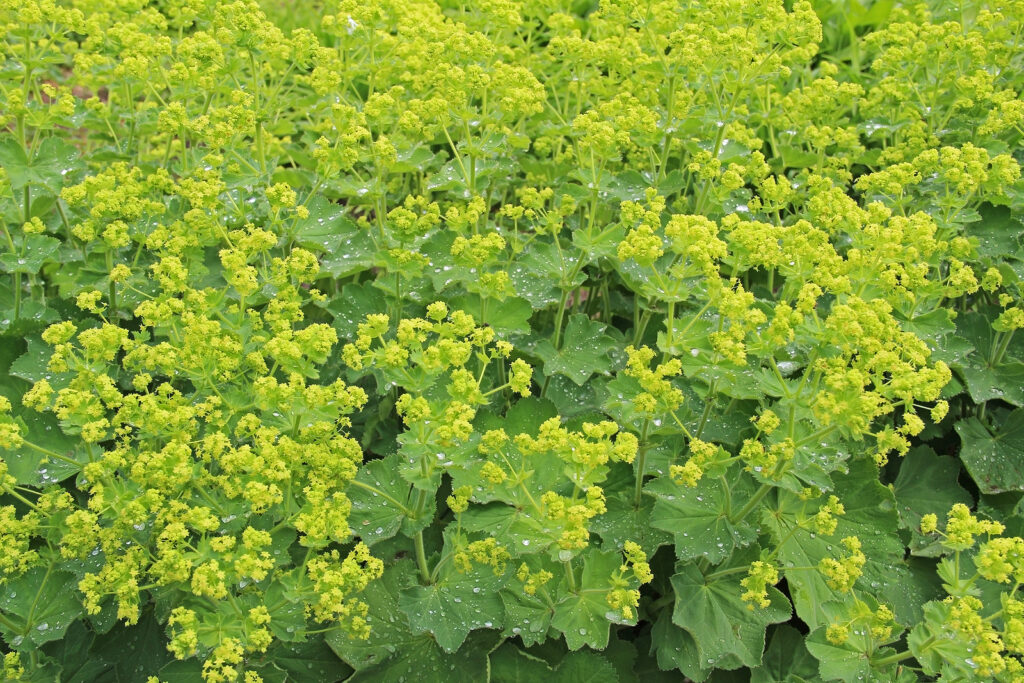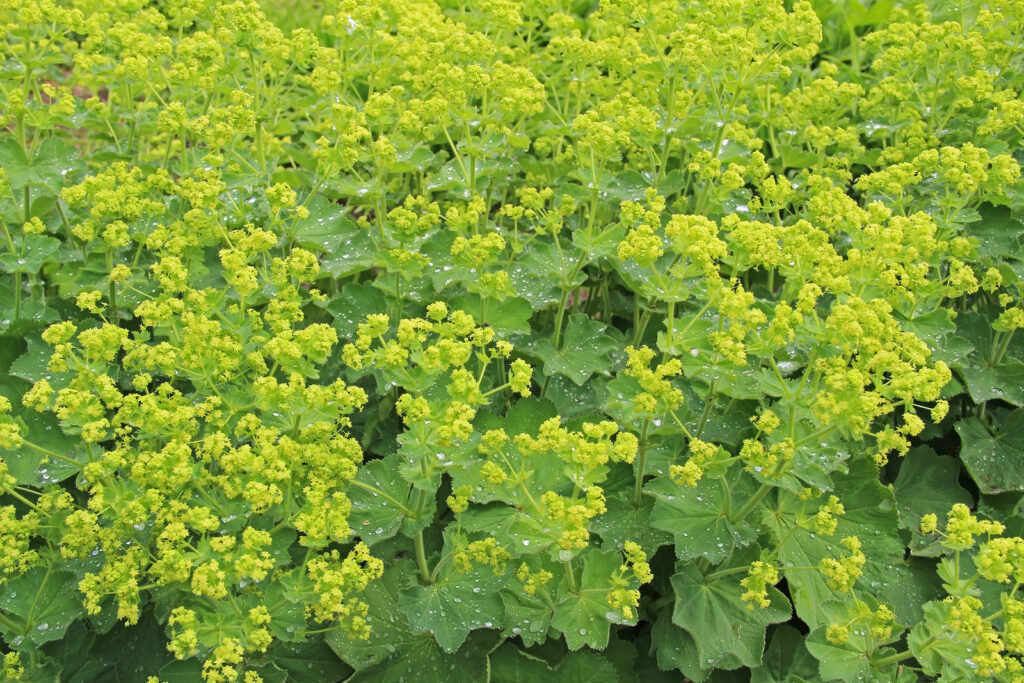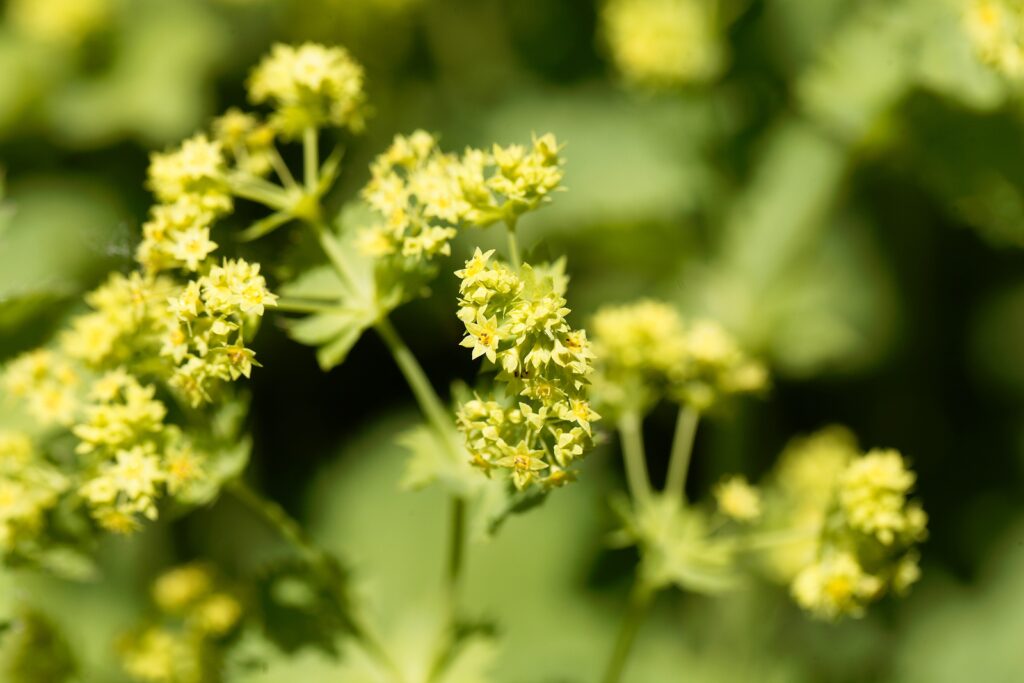Alchemilla–commonly called Lady’s Mantle– is a low-growing perennial with chartreuse blooms and rounded pale green lobed leaves that hold beads of sparkling morning dew on their surface. Commonly called lady’s mantle is often used as an edging plant or groundcover in shady places.
Alchemilla is a genus of low-growing, evergreen perennials of the Rose family. They are generally hardy with matlike foliage. They are desirable for rock gardens or low borders, blooming in midsummer.
Garden Success Products at Amazon:
- 10 pcs Stainless Steel Garden Hand Tool Set
- Flexi Hose with 8-inch Nozzle
- Gorilla Cart 4 Cu. Ft, 300-pound Capacity
- Neem Bliss 100-% Cold Pressed Neem Oil
- Safer Brand Insect Killing Soap
- Wildflower Seed Mix Attracts Hummingbirds and Butterflies
- Eden Brothers All Perennial Seed Mix
Sow seed where it is to grow in autumn or spring in well-drained soil with partial shade. Roots can be divided in mid-autumn or mid-spring.
The common name lady’s mantle comes from the resemblance of the rounded, crimped leaves to a lady’s cape.

Get to know Alchemilla
- Plant type: Hardy perennials
- Growing Zones and range: Zones 3 to 8
- Hardiness: Hardy to -40°F (-40°C); Alchemilla will die back in cold winter regions and re-emerges in spring; excessive heat can damage the foliage.
- Height and width: 1 to 2 feet tall; 12 to 24 inches (30-60cm) wide.
- Form: Mounded clumps of pleated foliage
- Flower form and color: Large branched clusters of nearly inconspicuous lime-green flowers look foamy from a distance
- Flower color: Lime-green, chartreuse
- Use: Good edging plant, cutting flowers, groundcover
- Bloom time: Early spring, early summer
- Uses: Grown primarily for green to lime-green foliage. Good edging plant, add to the front of formal and informal beds and borders
- Garden companions: Catmint, blue-flowered cranesbills, Siberian iris, hostas
- Common name: Lady’s mantle
- Botanical name: Alchemilla spp.
- Family: Roseaceae

Where to plant Alchemilla
- Plant Alchemilla in full sun to part shade; full sun in Zones 3-6 and the Pacific Northwest; in warm to hot summer regions plant lady’s mantle in partial shade.
- Grow Alchemilla in rich, well-drained soil.
- Alchemilla prefers a soil pH of 7.
Alchemilla uses and companions
- Alchemilla is an excellent ground cover or edging.
- Use Alchemilla in herb, cottage, or informal gardens where it can sprawl.
- Alchemilla flowers can be cut for fresh or dried use.
- Companions include Campanula, Digitalis, Geranium, Hosta, and Polygonatum.
When to plant Alchemilla
- Start plants from seed indoors 3 to 4 weeks before the last frost in spring; set out young plants after the last frost.
- Transplant Alchemilla into the garden or sow seed directly in the garden after the last frost.
- Sow seeds outdoors in late spring or summer.

Planting and spacing Alchemilla
- Sow Alchemilla seeds indoors in seed starting mix or light potting soil. Sow seeds 1/8 inch deep in bright light at 60° to 70°F (15.6-21°C).
- Seeds usually germinate in 4 weeks.
- Sow seeds outdoors in late spring or summer. Plants often self-sow.
- Thin or transplant during cool, moist weather when possible. Thin seedlings when they are 5 inches (12.7cm) high to 6 inches apart.
- Set plants in the garden after the last frost in spring.
- Space lady’s mantle 12 to 24 inches (30-60cm) apart.
- Set plants into beds that have been turned and raked after adding aged compost or commercial organic planting mix.
How to water and feed Alchemilla
- Alchemilla needs moderate moisture. Keep the soil evenly moist.
- Alchemilla will tolerate dry soil when planted in the shade.
- Feed Alchemilla with a slow-release fertilizer in spring.
Alchemilla care
- Mulch around plants to slow soil moisture loss.
- Trim off spent blooms to promote second blooms and prevent reseeding.
- Cut back tattered leaves; fresh leaves will soon appear.
- Cut the plant back by half if it becomes unwieldy; this will promote fresh growth.
Alchemilla pests and diseases
- Alchemilla is susceptible to fungal disease in humid regions, especially in the South. Mulch around plants to keep wet soil from splashing on leaves.
- Slugs and snails may attack Alchemilla.

Alchemilla propagation
- Propagate Alchemilla by cuttings in summer and seed in spring and fall.
- Divide crowns in spring or fall.
- Alchemilla often self-sows.
Alchemilla varieties to grow
- Alchemilla alpina is a mat-forming variety with creeping runners and flowering stems that grow 6 to 8 inches (15-20cm); plants are greenish-golden in summer; fine-textured leave.
- A. erythropods has deeply lobed leaves and red-tinted flower stems otherwise similar to A. glaucescens.
- A. glaucescens has dense foliage and flower stems to 8 inches tall; leaves are nearly round with seven to nine lobes.
- A. mollis grows 24 to 36 inches (61-91cm) tall and wide; large grayish leaves topped with foamy clusters of yellowish starlike blossoms; straw-textured flowers are best for drying when picked before they are fully open; cultivar ‘Auslese’ has erect flowers.
Alchemilla frequently asked questions
Q: Where will Alchemilla grow best?
A: Alchemilla will grow in most soils as long as the soil is not waterlogged. Alchemillas are hardy perennials and easy to grow. Give them full sun or partial shade.
Q: How do I propagate Alchemilla?
A: Sow see in spring. Divide established plants in autumn or spring.















